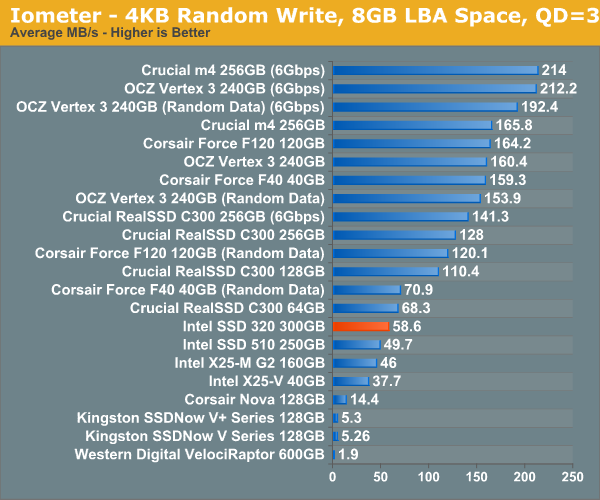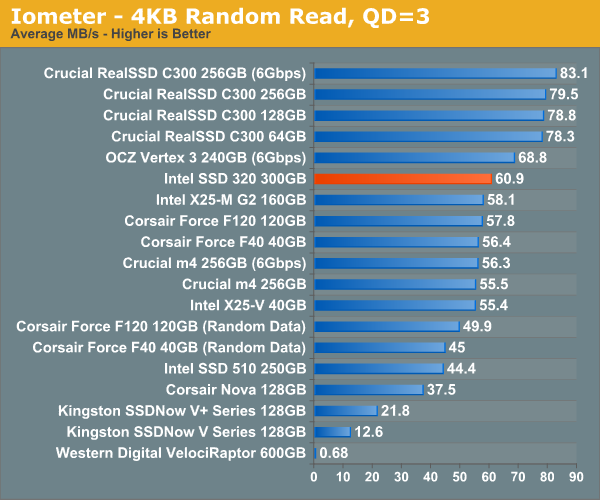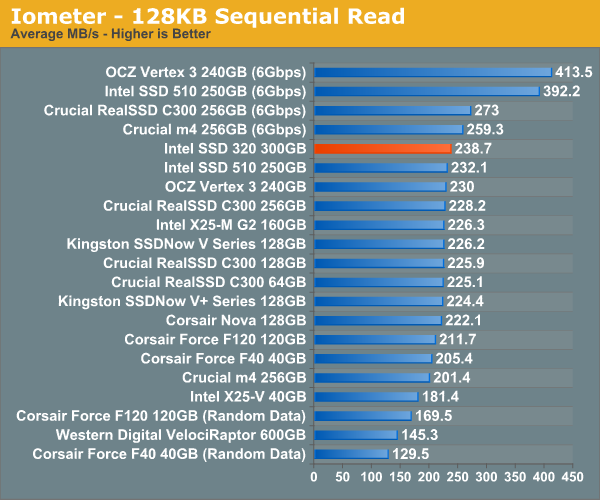The Intel SSD 320 Review: 25nm G3 is Finally Here
by Anand Lal Shimpi on March 28, 2011 11:08 AM EST- Posted in
- IT Computing
- Storage
- SSDs
- Intel
- Intel SSD 320
Random Read/Write Speed
The four corners of SSD performance are as follows: random read, random write, sequential read and sequential write speed. Random accesses are generally small in size, while sequential accesses tend to be larger and thus we have the four Iometer tests we use in all of our reviews.
Our first test writes 4KB in a completely random pattern over an 8GB space of the drive to simulate the sort of random access that you'd see on an OS drive (even this is more stressful than a normal desktop user would see). I perform three concurrent IOs and run the test for 3 minutes. The results reported are in average MB/s over the entire time. We use both standard pseudo randomly generated data for each write as well as fully random data to show you both the maximum and minimum performance offered by SandForce based drives in these tests. The average performance of SF drives will likely be somewhere in between the two values for each drive you see in the graphs. For an understanding of why this matters, read our original SandForce article.

Random write speed is improved compared to the 510 thanks to Intel's controller, but we're only looking at a marginal improvement compared to the original X25-M G2.
Many of you have asked for random write performance at higher queue depths. What I have below is our 4KB random write test performed at a queue depth of 32 instead of 3. While the vast majority of desktop usage models experience queue depths of 0 - 5, higher depths are possible in heavy I/O (and multi-user) workloads:


Random read performance has always been a strong point of Intel's controller and the 320 is no different. While we're not quite up to C300 levels, the 320 is definitely competitive here.
Sequential Read/Write Speed
To measure sequential performance I ran a 1 minute long 128KB sequential test over the entire span of the drive at a queue depth of 1. The results reported are in average MB/s over the entire test length.

Without a 6Gbps interface the 320's performance is severely limited. Compared to other 3Gbps drives the 320 is quite good here though.

Read performance is at the top of the chart for 3Gbps drives. I wonder how far Intel would've been able to push things if the 320 had a 6Gbps controller.










194 Comments
View All Comments
jwilliams4200 - Wednesday, March 30, 2011 - link
More OCZ spin doctoring. I was talking about using the drive heavily in a average consumer manner. For example, running CDM a couple times. The notorious Sandforce flaw causes the write speed of the SSD to slow down. No where is that flaw documented, so it is really worse than just a design flaw, it is a bug. If it were a known design flaw, there should be something in the spec sheet stating under what conditions the write speed of the drive will slow down. But there is nothing in the official specifications about that notorious Sandforce bug.sean.crees - Wednesday, March 30, 2011 - link
And no other companies have undocumented issues?How about my first gen Intel SSD's that now run at 1/10th their rated speeds? Where was it documented that this would happen to me?
So by your reasoning we should toss all Intel SSD's out of the window now right?
jwilliams4200 - Wednesday, March 30, 2011 - link
Intel G1 SSDs do not run at one-tenth their rated speed. There was a slowdown bug, perhaps a factor of two, but Intel long since fixed that with a firmware update.kmmatney - Wednesday, March 30, 2011 - link
Having several each of Intel and OCZ Agility SSDs, I can tell you that Intel's garbage collection is better, especially in first generation SSDs. I also have an Intel 80GB G1, and is is a little slower than new, but it hasn't slown down nearly as much as some of the OCZ drives I have do. Theya re all still much faster than spindle hard drives. I really do wish that Intel would at least enable manual TRIM of the G1 drives with the SSD Toolbox - but at least the grabage collection is very good.Frallan - Tuesday, March 29, 2011 - link
Im a happy Intel G2 user today but my 160 GB is running out bc of bl**dy Steam and their weekend/holiday offers. I have waited for the nexty generation of the Inteldrives bc of my experience with the G2 but with this they are 30% to expensive or 50% to slow.
Intel has failed in either pricing since this drive is a valuedrive or in execution since this is a slow drive. A year ago I would have stood in line allready but now it seems as if Ill have to go with the SandForce.
Just my 0.02 USD
/F
fackamato - Tuesday, March 29, 2011 - link
Same here. I also have the G2 160GB (good price on eBay almost a year ago). But the next one will not be this G3 drive, most likely something Sandforce.marraco - Tuesday, March 29, 2011 - link
Both the Intel 320 300GB and Intel 510 250GB are easily destroyed on price and/or capacity and/or performance by RAID 0 of Intel 320 40GB, 80GB, or Intel 510 120GB (in RAID 0 of 2, 3, or 4 units).I would only recommend Intel 320 80GB or Intel 510 120GB in different RAID 0 setups, but they were not tested.
Given the scalability of SSD units, the price/performance ratio is one of the more important aspects of SSD reviews. I wish Anandtech were giving more attention to the best price/performance in RAID 0.
NCM - Tuesday, March 29, 2011 - link
Remember what the zero in Raid 0 denotes...NCM - Tuesday, March 29, 2011 - link
...It's the amount of data you'll have left if any one member of the array fails.marraco - Wednesday, March 30, 2011 - link
I don't care, since I don't store data on SSD, and I have cheap terabytes of data to automatically store periodic images.